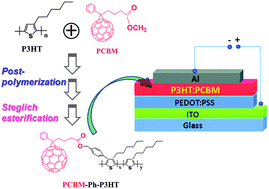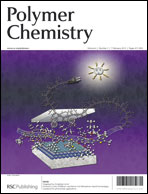A novel double cable donor–acceptor poly(3-hexylthiophene) (P3HT) derivative (PCBM-Ph-P3HT) was successfully synthesized via a facile postpolymerization approach followed by a Steglich esterification reaction, which was doped in a P3HT:PCBM (PCBM = [6,6]-phenyl-C61-butyric acid methyl ester) blend solution so as to study its effect on the device performance of P3HT:PCBM bulk heterojunction polymer solar cells (BHJ-PSCs). The successful attachment of PCBM as the side chain onto the P3HT backbone via a phenyl group is confirmed by both 1H NMR and UV-Vis spectroscopic studies. The fluorescence intensity of PCBM-Ph-P3HT in chlorobenzene shows ∼63% quenching of the fluorescence of P3HT, indicating a strong intramolecular photoinduced electron transfer between P3HT and PCBM moieties. PCBM-Ph-P3HT was doped into P3HT:PCBM blend solution with different doping ratios (1, 2 and 5 wt%) and the surface morphology of PCBM-Ph-P3HT-doped film was studied by AFM, indicating that PCBM-Ph-P3HT promotes the bicontinuous interpenetrating networks of the P3HT and PCBM components due to its amphiphilicity toward P3HT and PCBM like a “surfactant”. At the optimum PCBM-Ph-P3HT doping ratio of 1 wt%, the P3HT:PCBM BHJ-PSC devices doped by PCBM-Ph-P3HT show an enhanced power conversion efficiency (PCE), with the maximum PCE being 3.40% which has ca. 12% enhancement compared to that of the reference P3HT:PCBM device. The enhancement of PCE is evidently attributed to the increase of short-circuit current (Jsc), and proposed enhancement mechanism is that the improvement on the bicontinuous interpenetrating networks of the P3HT and PCBM components upon PCBM-Ph-P3HT doping leads to the increase of the charge carrier mobility.

You have access to this article
 Please wait while we load your content...
Something went wrong. Try again?
Please wait while we load your content...
Something went wrong. Try again?


 Please wait while we load your content...
Please wait while we load your content...